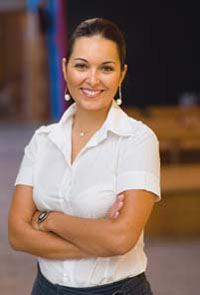This is the latest in a series of profiles of our MIT Energy Fellows—graduate students who are supported by MIT Energy Initiative (MITEI) members to participate in faculty-led research and become part of a long-term community of students and alumni.

Some buildings are cooled by water driven through pipes in the ceilings. Some have finely adjustable mechanical system controls. Some store thermal energy overnight to use the next day. Tea Zakula hopes to see buildings that exploit all three technologies in one system.
These buildings of the future could use up to 70 percent less energy. That’s an especially big number when you consider that in the United States, buildings account for more than 30 percent of overall energy consumption.
“If you want to have a big impact on energy, you have to concentrate on the biggest users, and buildings are definitely among them,” said Zakula, one of 40 MIT Energy Fellows supported by MITEI’s member companies. Zakula is sponsored by sustaining MITEI member Fundacio Barcelona Technologia, the b_TEC Foundation, which brings together businesses and universities to develop energy, water, and mobility innovations.
Since finishing her undergraduate degree in mechanical engineering at the University of Zagreb in Croatia, Zakula has been interested in heating, cooling, indoor air quality, and promoting natural ventilation in buildings.
Working with Leslie K. Norford, professor of architecture in the Building Technology Program at MIT, and Peter R. Armstrong, an associate professor at the Masdar Institute of Science and Technology in Abu Dhabi, Zakula said, her current research is on how to make cooling in buildings more efficient by combining radiant cooling, thermal energy storage, and highly calibrated controls to run the system.
Radiant cooling involves running tubes filled with chilled water in ceilings or walls. “Water has a large thermal capacity, so the same amount of water can remove a larger amount of heat” than air. Warm air rises and is cooled as it contacts the chilled ceiling, lessening the need for energy-intensive fans to supply a large volumetric flow of air, she said.
A thermal energy storage system looks like a tank that stores water cooled using less-expensive electricity during the night to lighten the energy load during hotter daytime hours.
A device called a variable frequency drive controls an HVAC unit’s compressor speed, which enables a wider range of working conditions. Instead of operating only in “on” or “off” modes, a cooling system that uses a variable drive compressor can be continually tuned, maintaining comfortable room conditions while saving energy.
The three systems—water-chilled ceiling tubes, thermal storage, and variable drives—are gaining in popularity in the United States as separate components but have never been combined. Zakula is modeling the potential benefits of using all three simultaneously. “I’m developing computer models to figure out the potential savings of using these three components in a combined system and how to operate that system for optimum performance in buildings,” she said.
“Professor Armstrong’s preliminary results show that by combining all three in one building, it may be possible to save 30 to 70 percent of energy for cooling,” she said. “It would be a huge amount of savings.”
From east to west
Zakula grew up in a city of 40,000 in the eastern part of Croatia. Her country’s Mediterranean coast, national parks, traditional architecture, and easy access to snow-covered mountains have made it an increasingly popular tourist destination, especially after the 1990s’ Croatian War of Independence.
Her hometown is rich in tradition. Involved since age 5 with a folk music ensemble for children led by her mother, Zakula plays more than 10 modern and traditional instruments ranging from the piano and classical guitar to quirky stringed instruments, including five kinds of tamboriza. She also plays rustic, deep-bellowing bagpipes made from the skin of a whole sheep.
She picked up songs on the bagpipes from old men in villages who still played the tunes of their childhoods. In college, she danced in a traditional Zagreb folk ensemble.
Running hot and cold
Zakula knew she wanted to enrich her experience and education by continuing graduate studies outside her country. “Especially in technical fields, it’s very important to experience different approaches and ways of thinking about the same problems,” she said. “I am dealing with energy in buildings, and buildings are complex systems, so it’s not possible to achieve the best solutions without an interdisciplinary approach.
“I think MIT has one of the best building technology programs,” she said. “This was the only place I applied, so I was lucky.”
Although Croatia’s climate is similar to Boston’s, Zakula said people in Croatia are not as dependent on air conditioning. Her family’s apartment, on the eighth floor of a 12-story building, had no AC. Almost all buildings have windows that open, allowing fresh breezes to provide indoor cooling.
Here, she said, buildings are often too hot in the winter and too cold in summer. In the hot weather, she carries a sweater to don in chilly restaurants and buildings. “It’s not natural to me, but I see people here feel that’s normal,” she said.
If Zakula’s research pans out, new construction may one day incorporate a system more high-tech than open windows but more energy-efficient than conventional air conditioning. She hopes to try out the system—if not in an entire structure, at least in a one-room prototype—in the near future.
“It’s very complicated to simulate and do on-site measurements for even one room in a real building,” Zakula said. “But if there is a place you can do it, I believe MIT would definitely be that place.”
Press inquiries: miteimedia@mit.edu